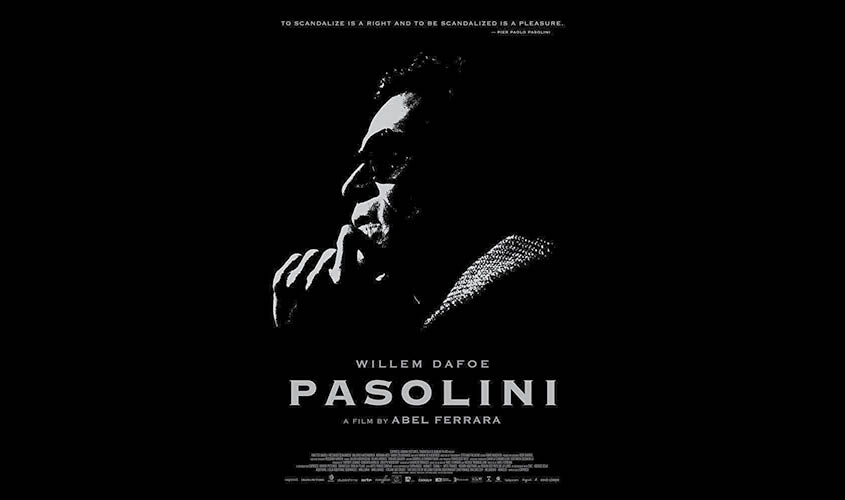In the autumn of 1975, at the Rome apartment he shares with his mother and a cousin, Pier Paolo Pasolini is giving what will turn out to be his last interview. A week after his body is found on a beach outside the city, the conversation will be published in La Stampa under the headline “We Are All in Danger.” Parts of it are reproduced verbatim (in English), in Abel Ferrara’s new film.
During the interview, Pasolini, played with melancholy poise by Willem Dafoe, is in a pessimistic, ruminative mood, contemplating a society so mired in corruption, violence and dishonesty that the only hope for the future may lie in its destruction. He also reflects on his own activity as a poet, essayist, filmmaker and novelist. “How do you define yourself?” he is asked. “As a writer,” Pasolini replies with a shrug.
His Olivetti typewriter serves as a talisman in this movie (first shown at the Venice Film Festival in 2014), which is more of an essay than a biopic. Pasolini, who was born in 1922, led an eventful and complicated life—Barth David Schwartz’s English-language biography runs to nearly 800 pages—and died a senseless and sensationally violent death at 53. Pasolini takes place mainly in the days leading up to his killing, but, if anything, Ferrara, a notorious provocateur in his own right, tries to dispel some of the feverish speculation and conspiracy-mongering that has surrounded that crime. His reverence for his subject as a fellow artist and kindred rebel spirit is evident in every frame, but he also works to strip away the layers of martyrdom and mythmaking that obscure the man and his art.
Somewhat surprisingly, given the penchant for extremity that Ferrara and Pasolini share, what emerges is mostly a sober portrait of the writer at work, with especially imaginative attention to the work itself. Dafoe, handsome and hollow-cheeked, not only bears a notable physical resemblance to his character, but he also seems almost mystically in touch with the man’s mind and sensibility. He accomplished a similar alchemy with Vincent van Gogh in Julian Schnabel’s At Eternity’s Gate, which channelled the ecstasy and torment of the painter’s inner life.
Pasolini’s temperament is quieter—for all his eloquence, his deepest gifts are for listening and observation—and more finely grained with contradiction. In a late poem, he declares his “endless capacity for obedience” and his “endless capacity for rebellion,” and Ferrara organises his film around that contrast, exploring how conservative and radical impulses can coexist within a single personality.
We see Pasolini doing postproduction on his last completed movie, Salo, or the 120 Days of Sodom, a scandal then and now for its graphic displays of sexual cruelty. He is quiet and disciplined; the images he makes are violent and chaotic. At home during the day, he obeys the routines of a settled bourgeois man of letters. His cousin, Graziella (Giada Colagrande), brings him coffee while he reads the morning papers. He goes over corrections on manuscripts, takes phone calls, sits down to lunch with his mother, Susanna (Adriana Asti), and some visiting friends. At night, he drives his Alfa Romeo through Rome’s poor neighbourhoods, looking for sex and companionship among the young men who loiter on street corners and in bars.
One of them, the 17-year-old Pino Pelosi, would confess to beating Pasolini and running him over with the Alfa, a confession he later recanted. Over the years, rival accounts of the crime have proliferated, involving the right, the left, the mafia and other forces that might have wanted to rid Italy of one of its most prominent and uncompromising social critics. Several movies have already been made about the killing, including Marco Tullio Giordana’s briskly forensic Who Killed Pasolini? Ferrara treats the homocide matter-of-factly, as a tragic act of homophobic violence that is neither inevitable nor the summation of the victim’s life.
Pasolini is a reminder of that life and some of its meanings, rather than an attempt to render its fullness. When asked if he thinks sex is political, Dafoe’s Pasolini answers that “everything is political.” But the film isn’t really, at least not in the sense of engaging the ideological battles that commanded so much of his energy and attention. A maverick Marxist and a heterodox Catholic, Pasolini was a scourge of the long-governing Christian Democratic Party and an irritant to the Communists as well. He was hugely popular and widely hated. After his funeral, 10,000 people gathered in Rome’s Campo de’ Fiori to mourn.
None of that figures in Ferrara’s movie, an omission that has the effect—and, I think, the intention—of liberating Pasolini from his time. As exquisitely detailed and historically accurate as many of its scenes are, Pasolini is less concerned with the realistic reconstruction of the past than with communicating a mood in the present. The actors speak various languages in sometimes awkward accents. Important characters arrive without introduction. Not much is explained. That’s what Wikipedia is for.
The most audacious and rewarding sequences take leave of biography altogether and imagine moments from projects—a novel and a film—that Pasolini left unfinished or barely started. The blend of pornography and humour, obnoxiousness and elegance, sweetness and cruelty reminds you that this is, above all, an Abel Ferrara movie. And the splendor of Pasolini lies in its essentially collaborative nature. The mischievous visionary responsible for King of New York, Bad Lieutenant and The Addiction didn’t just make a movie about the polymath responsible for Accattone, Teorema and The Gospel According to Saint Matthew. They made it together.
© 2019 The New York Times

